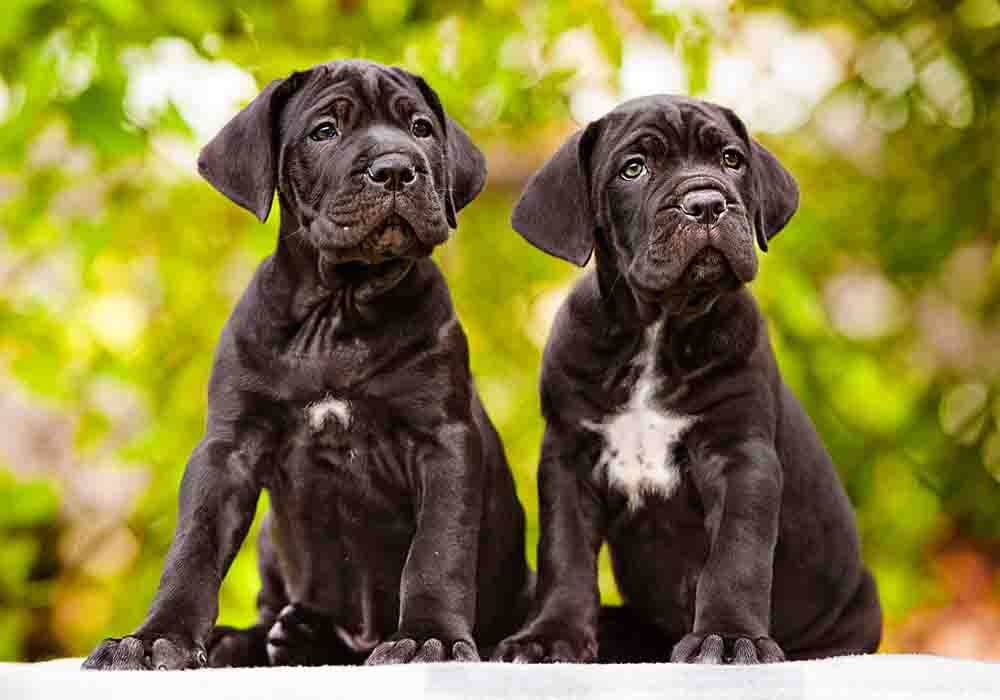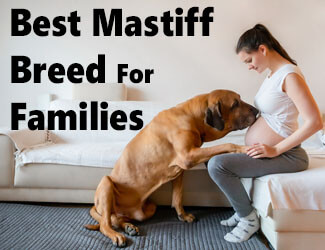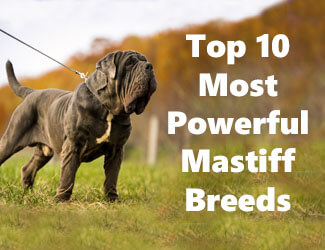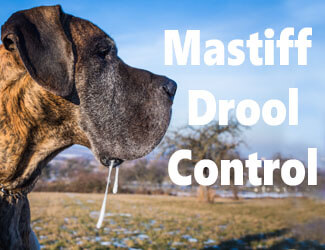Best Mastiff Breed for Families
Or First Time Owners
The Most Popular Top 6 Compared
by Ken Alden
When considering a Mastiff as a pet, finding the best Mastiff breed for families or first time owners can be made easier when some commonly asked questions families might ask are addressed first.
What Is The Best Mastiff Breed For Families?
As a whole, the best Mastiff breed for families or first time owners is one that is both protective and loyal. English Mastiffs, Great Danes, Bullmastiffs, and French Mastiffs are good family and first-time owner choices to name a few.
Anyone who’s had a dog knows that the perfect dog will become a part of the family. And while a dog doesn’t have to be trained when they come home, they should be good with kids. Choosing the best mastiff breed for families or first time owners will help you decide on the next addition to your home. Read More Below...
Pro-tip: Ever try lifting a Mastiff? Their weight can hurt not only your back but their joints when they hop down from cars, sofas or even your bed. To protect your back and theirs check out the best Mastiff ramps on Amazon.com now.
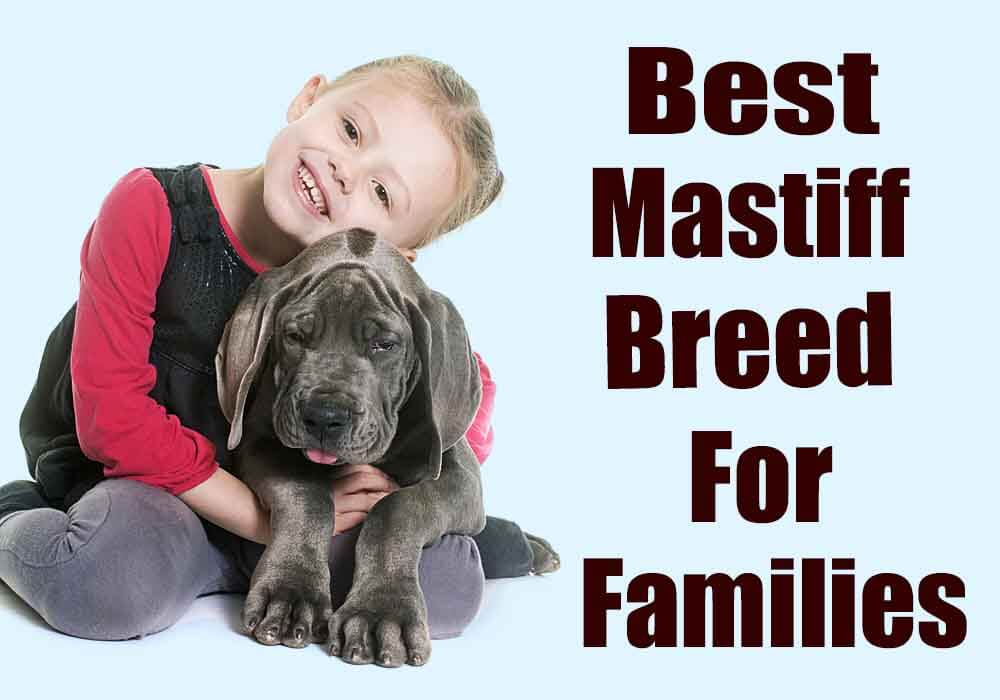
Overview of Mastiff Breeds
Contrary to popular belief, the
mastiff is not a single breed. The mastiff family covers multiple breeds with
similar characteristics, though some are quite different. That means that some
mastiff breeds are a better fit for families than others.
Of the common breeds, not all are the best Mastiff breeds for families. Some don’t do well with kids, and others require a lot more training and socialization. Most mastiffs make excellent guard dogs, but the different mastiff breeds have unique features.
● The English Mastiff is a large yet gentle dog breed. These dogs can weigh over 200 pounds, but they can fit in well in a family.
● Another popular mastiff breed is the German Mastiff, though you may better know them as Great Danes. These dogs are friendly, and they typically weigh over 100 pounds.
● If you like mastiffs and bulldogs, you’ve probably heard of the Bullmastiff. This mixed breed dog combines the qualities of both breeds, and they make great pets.
● French Mastiffs are smaller than English Mastiffs, but they can be just as powerful. At over 100 pounds, these dogs make good watch dogs.
● Another common mastiff breed is the Neapolitan Mastiff. These dogs might be what you think of when you think of mastiffs. They weigh over 100 pounds, and they can take up a lot of space.
● The Tibetan Mastiff is another common
mastiff breed. These dogs can be very protective of their families, and they
require much socialization when they’re young. By far they're the hairiest of
the Mastiff breeds which gives them a distinctive look.
Believe it or not, there are over a dozen mastiff breeds, so this
list only covers part of the mastiff family. But that variety means that
each mastiff breed has something to offer you and your family. However,
not all are the best Mastiff breeds for families nor are the best choices for first time owners.
So before finally making your final choice be sure to check out our article about the different types of Mastiff breeds. We think you'll find it a fascinating read.
Also, before you bring
home a mastiff, consider the different qualities of the breed as well as
of the whole mastiff family. Think about how those qualities do or do
not fit with your family or as a first time owner.
Mastiff Qualities That Are Common
Despite the numerous breeds in the mastiff family, all mastiffs tend to share a few qualities. Some of the breeds might have more of one trait than another. And not all traits will be compatible with all owners. Realizing this we branched out into a separate article which gives even more helpful information about what their personalities are like which we think you'll find of interest.
Still, the mastiff family has a lot of great traits that make these dogs worthy companions. While you can’t choose the exact personality of your family dog, you can consider common characteristics of specific breeds. That way, you can select a breed that’s more likely to have the features you want.
Some of the most common traits include loyalty and protectiveness. The mastiff’s size makes the dog a good guard dog, and many of them love living with people.
Are Mastiffs Loyal?...You Bet
Dogs are called “man’s best friend” for a reason. Many dogs develop a sense of loyalty toward their owners, and mastiffs are no different. Mastiffs are loving dogs, and they will do what they can to protect their own from harm.
Whenever an unknown visitor comes to your home, a mastiff will most likely stand their ground. Your home is your dog’s territory, and mastiffs will be protective of their space. This means that you should socialize your dog as much as possible when they’re young. Keep in mind though that even when standing their ground they tend to not be aggressive so they might better be categorized as a good "watch dog" and not a "guard dog".
Of course, loyalty is a
fantastic trait for any dog. However, that loyalty might make your dog
more protective when you have friends over. Still, when you’re home, you
can hang out with a mastiff, and they will probably be just fine on the
couch.
Pro-tip: Mastiff anxiety, aggression, destructive chewing, jumping up, fearfulness, and other behaviors can be controlled with the right training program.
Here’s a great course that
addresses these issues along with many other dog training basics: Check it out now!
Are Mastiffs Calm Dogs Or Aggressive?
It may come as a surprise, but mastiffs can be quite calm dogs. When they aren’t busy defending you or their territory, they can be easy going. This can be an excellent quality for any dog, but even more so for a dog that will be in a family with kids.
Now, mastiffs can be overbearing when living with younger children and toddlers. A mastiff’s size can be enough to be scary for younger family members.
However, as your children grow and get older, a mastiff can be the perfect dog. Since mastiffs are typically very calm, you shouldn’t have to worry about them getting worked up. Sure, that can change when guests arrive, but it’s all a part of the mastiff’s nature.
When It Comes To The Best Mastiff Breed For Families, If Looking For A Good Guard Dog You Might Want To Consider A Cane Corso...
Mastiffs Are Active
We can’t emphasize enough how a mastiff’s size affects their life. Most mastiff breeds need some amount of physical activity each day. That way, they can maintain their muscles and bones.
However, some breeds need more exercise than others. Breeds like the English Mastiff need daily exercise. On the other hand, German Mastiffs, or Great Danes, do well indoors, though they still need some activity.
The Neapolitan Mastiff is another breed that doesn’t need as much exercise as some. However, that doesn’t mean they don’t need attention and care.
Active or not, the Tibetan Mastiff needs to stay engaged. If they get bored for too long, they might start to destroy your property. This can happen when they’re alone or if they’re in a confined space. If your family is always on the go where you'll be leaving this dog alone during the day, then this might not be the best Mastiff breed for families.
Are Mastiffs Good With Kids And Babies?
While not all mastiffs are, many mastiff breeds are good with kids and babies, even if it takes some training. Some mastiff breeds are better suited for hunting and guarding, and they’re not the best house pets. But for the breeds that are good with kids, they tend to be very good with kids.
The best mastiff breeds for families are the ones that are good with kids. After all, you don’t want to have a dog that will hurt or scare your family. Of course, some individual dogs may be better or worse with children than other dogs.

Just how good are mastiffs with kids? Can they be trusted? Read up on this important article dedicated to answering just this question.

Considering their BIG size, are babies safe around mastiffs? What are some of the things to watch out for if you bring a mastiff home?
Best Mastiff Breed For Family Pet...
If you want to bring a mastiff home, you need to choose the right mastiff breed. We’ve mentioned that many dogs are family-friendly and great choices for new owners, though some aren’t. However, going for the right breed will increase your chances of finding a dog that will fit in like they’re part of the family.
● As mentioned, the best mastiff breed for families is one that’s good with kids. There’s no place for a dog if they don’t get along with everyone in the house.
● A good mastiff breed for families and first time owners should also be calm and easy-going. Families have a lot going on, and children can be especially curious, so you need a dog that won’t get frustrated or aggressive at the drop of a hat.
● Loyalty is also an essential part of any good mastiff breed, more so if you want your mastiff to also serve as a guard dog. A loyal dog is more likely to work to protect their family and space.
● Depending on your family life, you may want a breed that is more or less active. If you don’t have much time to exercise your dog, you should choose a less active breed. On the other hand, a more active breed can be good if you like to go on walks with your dog.
The mastiff family of breeds is one filled with different qualities, and some may suit your needs better than others. But if you’re looking to add a mastiff to your family, you need to consider some of the best mastiff breeds for families and first time owners...
Pro-tip: Mastiff's (and their owners) love dog crates…and for good reasons. Crates keep dogs from mischief while you're away, are perfect for house training, for traveling by car, and provide the dog a place to de-stress. Check out the best Mastiff crates on Amazon.com now.
The Top 6 Best Mastiff Breeds For Families
The English Mastiff
The English Mastiff is a large dog to say the least, and they can be very loving and kind. These dogs are easy-going, and their gentle nature makes them great pets. English Mastiffs can be very devoted and loyal toward their family.
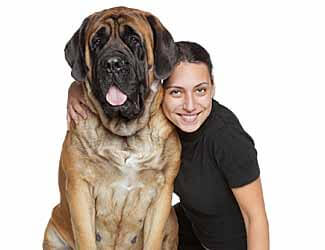
Male English Mastiffs can weigh up to 230 pounds, and they measure about 36 inches. Female English Mastiffs weigh up to 170 pounds, and they also measure approximately 36 inches. This breed is great with kids.
You don’t have to have a ton of experience owning dogs before you own an English Mastiff. However, you should have some towels on hand. English Mastiffs can drool a lot, and they can snore.
The good news is that you don’t have to spend a lot of time grooming or maintaining their coats. You will have to make space for them, though, so that they have enough room to relax. But once you do bring an English Mastiff home, you can integrate them into your home.
Want To Learn More About Them?...
Just how family friendly is this particular breed? We dig much deeper answering further questions as well as offering more pros and cons that you should consider in this article...
The Great Dane (or German Mastiff)
The Great Dane, or German Mastiff, is another popular mastiff breed. These dogs are large, but they’re also relatively gentle. Great Danes tend to be friendly and dependable dogs, and they can also be very good with kids.
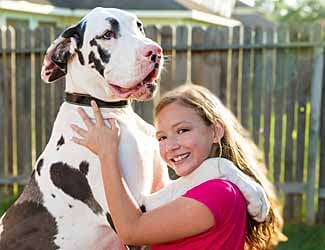
You can keep a Great Dane indoors for much of the time, and they will be happy. However, they can use a moderate amount of daily exercise. You can take them on a walk or let them play in a backyard or other enclosed outdoor space.
The Great Dane does well with other household pets, which can be helpful if you want more than one dog. However, you may need to keep an eye on this mastiff. Great Danes aren’t always aware of their size, so they can be clumsy.
Male Great Danes weigh at least 120 pounds, and they can be up to 30 inches tall. Female Great Danes weigh a minimum of 100 pounds, and they can reach 28 inches tall. Some Great Danes might drool, but it’s not as common as in English Mastiffs.
Want To Learn More About Them?...
This majestic dog deserved further coverage and a closer consideration as one of the best mastiff breed for families so we did a "dig deeper" article which we think you'll find helpful when making a final decision for your family or as a first time owner. Find our article here.

Just how good are Great Danes around kids? Are they friendly?Can they be trusted? This article answers all questions you might have.
The Bullmastiff
Perhaps you can’t decide between a family-friendly mastiff and a bulldog. In that case, the Bullmastiff might be the best mastiff breed for your family. Bullmastiffs are a cross between the popular Bulldog and the Mastiff.
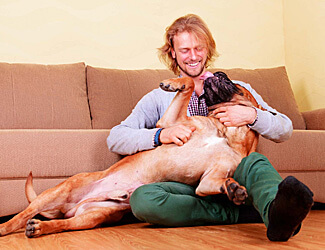
These dogs tend to be quiet and gentle, but they can guard your family when the need arises. They are laid back, and they don’t anger very easily. However, they can become protective when they feel threatened.
One of the less attractive qualities of Bullmastiffs is their stubbornness. Male Bullmastiffs can be very stubborn and aggressive toward other male dogs. The good news is that they are very good with kids, especially when raised together.
Male Bullmastiffs weigh up to 130 pounds, and they can be up to 27 inches tall. Female Bullmastiffs can weigh up to 120 pounds and be up to 26 inches tall.
Want To Learn More About Them?...
Here's an article of ours that offers more in depth coverage on the Bullmastiff as a family dog as well as things that would make it more or less appealing to families or first time owners. There's a lot more to this dog than meets the eye.

Just how good are Bullmastiffs with kids and babies? This in depth article of ours answers all your questions on this important topic.
The French Mastiff
The French Mastiff, or Dogue de Bordeaux, is another good mastiff breed for families. They have powerful bodies, but they don’t always feel the need to exert that power. They’re smaller than English Mastiffs, and they can be both calm and patient.
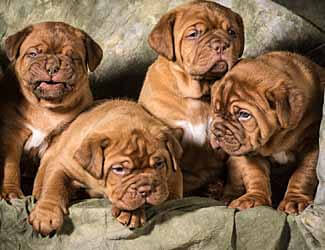
French Mastiffs are loyal and calm with their family members. However, the breed can be more aggressive with strangers. These dogs also appear not to be scared of anything, which can make them excellent guard dogs.
To be best with kids and other pets, French Mastiffs need to be socialized when they’re young. That way, they can learn who is okay and who is part of their family. Despite their size, these dogs tend to be very gentle with their owners, including kids.
Male French Mastiffs weigh up to 150 pounds, and they can be about 27 inches tall. Female French Mastiffs can weigh up to 125 pounds and reach about 26 inches in height.
Want To Learn More About Them?...
We've compiled an in depth list of 8 pro's and con's about this breed that all potential owners should know about when considering the best mastiff breed for families. This will provide a more detailed view that's vital to know before committing to bring one home.
The Neapolitan Mastiff
A Neapolitan Mastiff is another excellent choice for families or first time owners. This breed is a popular member of the mastiff family and for good reason. Neapolitan Mastiffs are very loyal toward their owners, and they were bred to be a guardian dog.
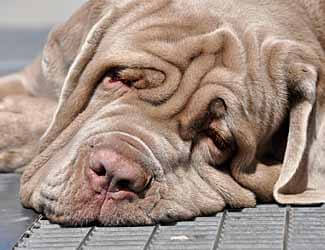
These dogs are devoted to their families, and they can watch over you. They don’t trust strangers, and it can take time for them to open up to people outside of your family. However, with enough socialization, they can be great with kids.
Neapolitan Mastiffs also don’t need a ton of exercise, so they can be a great option if your family has a busy schedule. Still, they’re not for everyone, and only experienced dog owners should bring home a member of this breed.
Males weigh up to 150 pounds, while females weigh up to 130 pounds. A male can be about 30 inches tall, and a female might be about 28 inches tall.
Want To Learn More About Them?...
Be forewarned...this dog is stubborn! There are also a few temperament issues you should consider before bringing one home. We think you'll find this article of ours enlightening as to things you might not have known or considered.
The Tibetan Mastiff
The Tibetan Mastiff is another candidate for the best mastiff breed. This dog is large and protective. While they were bred to protect livestock, that nature can apply to you and your family.
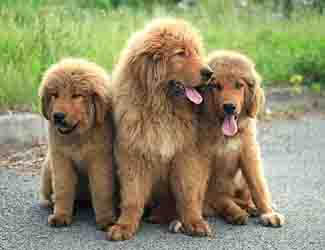
These dogs are very independent and protective of their territory. They are very loyal to their owners and family, but they don’t pay much attention to strangers. Ideally, this breed does need socialization at a young age if they will be around children.
A Tibetan Mastiff requires stimulation because they can become destructive if they get bored. They like to be active outdoors, though they can be calm when indoors. These dogs do have thick coats that need regular brushing.
Male Tibetan Mastiffs weigh up to 160 pounds, and they can be up to 30 inches tall. Females can weigh up to 120 pounds and be up to 28 inches tall. But despite their large size, these dogs tend to be very patient, and they do well in both cool and warm climates.
Want To Learn More About Them?...
Even though they're great with children they're large size can make them unsafe around really young children. They also love to bark, and when they do the whole house will shake...it's that loud!
For more about them please be sure to visit our page which goes in depth about their good and bad traits and qualities, it makes for an interesting read when considering the best mastiff breed for your family.

Are Tibetan Mastiffs good with kids and babies? We address this topic in depth in this dedicated article.
Final Thoughts On The Best Mastiff Breed For Families
The mastiff is a family of breeds rather than a single breed, and not all members are good with families or as first time dogs. The best mastiff breed for families might be the English Mastiff. However, the other Mastiffs we discussed are just as protective yet calm, so you should consider them as well when choosing your next family pet.
Return to the top of this Best Mastiff Breed For Families page

About the Author...
Ken Alden, a dedicated Mastiff owner for over eight years, is acclaimed for his expertise in care, grooming, and training. Read more About Me and my dog Shadow.
- Mastiff Guide Home ›
- Mastiff Dog Information ›
- Best Mastiff Breed For Families

